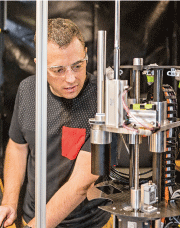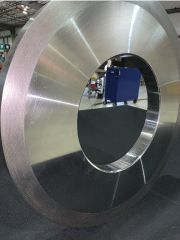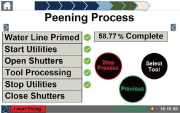Customer demand has spurred LSP Technologies to expand its line of laser peening systems to include both systems for hazardous environments and specialized systems for tight spaces and complex geometries of parts.
“Our customers have asked us to provide equipment that will work onboard combat ships, in nuclear reactors, and in aircraft maintenance depots,” said company founder, president and CEO Jeff Dulaney. “That’s where you not only find some hazardous environments for precision machinery, but also large systems and intricate components that need laser peening.”
To meet that demand, the company has expanded its product offerings, thanks to advances in technology and design.
New models and custom equipment
New custom equipment has essentially evolved rapidly into an adaptive product scheme for LSPT and its customers, building on the base of its successful Procudo® 200 Laser Peening System, a multi-purpose metal improvement platform used both by the company at its Dublin, Ohio USA headquarters and by other advanced manufacturing centers and customers around the world.
Major projects for Airbus, the U.S. Navy, and a major nuclear power player have led to several new models being delivered last year and in 2021. The number in each model name refers to the average watts of laser power output:
Procudo® 200 XE – an extra-rugged version
The Procudo® 200 XE has robust housings and components for extreme environments, from onboard combat vessels in dry dock to nuclear plant maintenance, where it needs to operate at higher temperatures. The 200 XE can be moved between various environments via container shipping or truck.
Procudo® 60 System – smaller and versatile
The Procudo® 60, a lower-powered laser peening system, ships easily and moves on wheels with front and rear handles. The portable system typically involves custom tooling to process specialized components, but multi-purpose generic tooling for virtually any metal surface is also available.
Procudo® 60 HFO – with fiber optic laser beam delivery
The Procudo® 60 HFO variation adds fiber optics for highly flexible laser beam delivery, especially for small metal penetrations and channels within large mission-critical systems for aviation maintenance and other intricate applications.
Procudo® 140 – twice the power with significant speed gains
The Procudo® 140 Laser Peening System, now in commercial development, will provide more than twice as much energy as the 60-watt model. It includes a high repetition rate laser beam delivery scheme, providing rapid treatment of parts as a precision alternative to shot peening. This 140-watt model can deliver 700 millijoules of laser energy at 200 Hz (pulses per second) for deep compressive residual stress levels and highly efficient coverage speed.
“There are other laser peening systems competing for market share, but our systems are more flexible in placement, and they can fit into multiple environments better than anything else that's out there right now,” Dulaney said. “We can use a crane to set the Procudo® XE System on a ship deck or go inside a nuclear reactor to extend fatigue life on truly mission-critical parts.”
“All these options allow us to pull from our product portfolio of lasers to bring the right one for an application and match the performance and the throughput requirements – and do better on cost,” Chief Operating Officer Eric Collet said. “Our strength in beam delivery, automation, software and controls allow us to succeed in a wide variety of applications,” Collet said.
To get a look behind the scenes for the new equipment, LSPT engineers and product developers discussed several key technologies.
Smaller Systems to Replace Shot Peening
Controlled factory floor conditions do not always require the full-sized Procudo® 200, Collet said. Sometimes smaller is just right. “We knew customers need systems that fit in a relatively small footprint and deliver at the speed of other advanced manufacturing equipment, but we have found the market for lower power laser peening systems is emerging as a major opportunity,” Collet said.
Both laser peening and shot peening provide compressive residual stress, but laser peening is more precise, controllable, deeper, and more repeatable than shot peening, with less downtime, waste, and maintenance cost, so the smaller models, particularly the Procudo® 140 system, can serve as shot-peening alternative schemes where practical.
“The smaller systems in our fleet of offerings are sometimes the most appealing because they allow us to keep costs down,” Collet said. “We don't need the hardened Procudo® 200 System necessarily to deliver the same levels of compressive stress as shot peening. When the solution does not require a big hammer, pull out a smaller hammer.”
Dulaney agrees. “I believe we're also going to end up with an even smaller version of the Procudo® 60 system, equipped with fiber optics, that may not move around, but only takes up a 4’x6’ or 4’x8’ footprint,” he said.
Tight Spaces Driving Innovation
The smaller systems are designed to address unique features or requirements in complex components. That involves extensive design work, as well as intensive collaboration among engineering disciplines. But the science – and the engineers and scientists who understand it – is key.
“We've built expertise in addressing complex part geometries, complex beam delivery systems and tools, reaching inside of narrow penetrations in metal, and underwater laser processes,” Dulaney said. “That means pairing the laser beam with new tools to position the beam, deeply understanding the impact of the beam on metal, and taking the distance into account between the lenses focusing the beam and the surface, which could be anywhere from a few millimeters to a few feet.”
Developing these systems involved close teamwork and concurrent development practices, bringing together the collaborative team’s talents in lasers, optics, mechanical engineering, electrical engineering, and software and hardware controls. “It’s very difficult to deliver these complex laser peening systems on time if you don’t break out of a serial process and consecutive handoffs, one engineering discipline at a time,” Dulaney said.
Custom Tooling for Laser Beam Delivery
In only two years, LSP Technologies has added a new dimension to its standard laser beam delivery method, which had once exclusively been a stationary laser beam with a moving part manipulated by robots. Now however, robots and custom tools are moving the laser beam delivery itself, with a wide variety of custom tools depending on customer needs.
“Often, our tooling and optics are very close to the metal surface, but we’ve met the challenge to maintain high-quality beam delivery through precise management of optics, water, and air,” said Derik Burkholder, Head of Mechanical engineering.
“We’ve had so many breakthroughs,” said Mark Bloomberg, VP of Engineering. “For example, we have got a very deep understanding of the interactions happening at the metal surface, just after the laser beam generates the plasma pressure. That helps us ensure that when the next pulse arrives, we are generating the correct pressure wave into the material, particularly in these very tight locations. It is not what we do with the laser, air, water, optics, or mechanics in isolation. It’s really a combination of all those things and the expertise to make them work together.”
Modeling and Additive Manufacturing
FEA modeling of customer parts and LSP Technologies’ deep library of alloys and peening data typically speed customer application development. Now, modeling has enabled big strides on the equipment side, especially development of custom laser beam delivery systems.
The mechanical team can translate computer designs into reality via in-house rapid prototyping capabilities with SLA and FDM 3-D printers. A number of additively manufactured (AM) composite parts from the in-house units have entered new equipment offerings, said Burkholder.
“Customers in the tool and die arena are doing this too, especially for putting coolant channels into their dies,” he said. “They can do that work with machining, but they can do it faster and typically cheaper with AM. We recognize the value in this, especially given that some AM composites can provide significant strength and reliability.”
Self-Monitoring, Self-Calibration, and Artificial Intelligence
Since 2017, the Procudo® Systems have always included self-diagnostic and self-adjusting technologies to monitor power levels, assure laser beam quality, and deliver accurate spot size, as well as monitoring for chillers, water flow, hydraulics, and air flow intrinsic to the laser-peening process.
“We have calibration and energy level data accessible from every point in the system, and new artificial intelligence software is noticing new patterns we can use to anticipate and avoid many common issues,” said Michael Yao, head of Controls Engineering. “For example, the algorithms will respond if you run a machine or process every day from 9 a.m. to 6 p.m. If that schedule gets interrupted, the system alerts us and the customer operators about the interruption.”
Remote Monitoring Worldwide
LSP Technologies has added remote monitoring and diagnostic service for the Procudo® Laser Peening fleet, helping LSP Technologies Technical Services notice alerts for routine maintenance and alarm conditions remotely just as quickly as customer operators do at the plant, said Yao.
With Procudo® Laser Peening Systems in the U.S., China, and Germany, the Controls Engineering team maintains details on every subsystem for remote monitoring across all measurements of supplies and calibrated variables. “We've deployed a cloud-based monitoring system that allows us to monitor what's happening across multiple laser-peening systems and that has enhanced our Technical Services for all customers,” Bloomberg said.
The remote system follows international ISA99 cyber-security standards, providing several benefits. Some software updates can now occur remotely for units in both domestic and international locations. “During a recent trip to our Chinese joint-venture partner, we set up remote monitoring equipment,” Yao said. “We can push software updates here while they sleep in China, staggering times so as not to take up their valuable workday hours. That will reduce equipment installation and commission time on future international systems.”
Enhanced Interface for Easy Operation
To support the need for easy operation by maintenance and factory operators, LSP Technologies has moved toward simpler linear HMI screens in its smaller laser-peening systems, often rebuilding the Human Machine Interface from the ground up, said Yao.
“We’re making the HMI more attuned to workflow, matching the linear path operators typically take in operating the equipment. We’ve eliminated a lot of clutter and toggling back-and-forth between screens,” Yao said. The systems will still be more intricate than a home appliance, but novice users will be able to operate them without advanced laser or laser-peening knowledge.
Fluid Dynamics Modeling
With ever-smaller, ever-faster, and ever-more flexible laser-peening systems still ahead, the core technologies driving these kinds of innovations provide a glimpse into the future, Collet said.
“We’ve invested heavily in understanding optics, modeling metal stress, and computational fluid dynamics modeling,” said Bloomberg. “That has yielded many equipment innovations – and customer applications – that have worked out well on the first try.”
“We’ve worked very hard for the last 20 years to get to this point in sophisticated modeling,” said CEO Dulaney. “Now the tools are so reliable, predictive, and sophisticated enough – and our people have adopted them so well – that we can drive through to better applications and equipment with great confidence in the end result.”
For Information:
LSP Technologies, Inc.
6161 Shamrock Court
Dublin, Ohio 43016-1275, USA
Tel. +1.614.718 3000
Fax +1.614.718 3007
E-mail: dlahrman@lspt.com
www.lsptechnologies.com




































